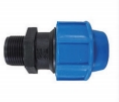Dec . 29, 2024 20:23 Back to list
ppr hot and cold water pipe product
Understanding PPR Hot and Cold Water Pipes A Comprehensive Guide
In the ever-evolving field of plumbing, the choice of materials plays a pivotal role in determining the efficiency, durability, and overall performance of water supply systems. Among the various materials available, Polypropylene Random Copolymer (PPR) pipes have garnered significant attention and popularity, particularly for hot and cold water applications. This article delves into the characteristics, advantages, installation methods, and applications of PPR hot and cold water pipes.
What is PPR?
PPR, or polypropylene random copolymer, is a type of thermoplastic polymer that is widely used in piping systems. The random structure of the polymer chains gives PPR its unique properties, making it suitable for various applications, particularly in plumbing. The pipes are typically available in a range of diameters and are known for being lightweight, strong, and resistant to various forms of chemical corrosion.
Advantages of PPR Pipes
1. Durability PPR pipes are known for their long lifespan, often exceeding 50 years under ideal conditions. They are resistant to scaling and corrosion, which means they can withstand the rigors of both hot and cold water systems without deterioration.
2. Thermal Resistance PPR pipes can handle high temperatures, making them ideal for hot water supply systems. They can typically withstand temperatures up to 95 degrees Celsius (203 degrees Fahrenheit), ensuring reliability in high-temperature environments.
3. Smooth Interior Surface The internal surface of PPR pipes is smooth, which reduces friction and helps in maintaining a steady flow of water. This also minimizes the buildup of deposits, ensuring clean and uncontaminated water supply.
4. Lightweight and Easy to Handle Compared to traditional materials like PVC or metal, PPR pipes are significantly lighter, making transportation, handling, and installation much easier. This lightweight nature also leads to lower shipping costs.
5. Joint Flexibility PPR pipes can be welded together using heat fusion methods, creating strong and leak-proof joints. This minimizes the risk of leaks that can be prevalent in other types of piping systems that rely on fittings or adhesives.
ppr hot and cold water pipe product

Installation of PPR Pipes
Installing PPR pipes requires specific techniques to ensure durability and reliability. The heat fusion process is the most common method, where the ends of two pipes are heated until they reach a molten state and then pressed together to form a solid bond. This method eliminates the need for additional fittings, creating a seamless flow path.
Before installation, it is essential to consider the local building codes and standards to ensure compliance. Proper planning involves measuring the required lengths, determining the correct pipe diameters, and ensuring that the installation environment is suitable for PPR pipes, especially concerning temperature and pressure.
Applications of PPR Pipes
PPR hot and cold water pipes are versatile and can be used in various applications, including
1. Residential Plumbing From hot water heaters to bathroom and kitchen installations, PPR pipes can be found throughout residential buildings, providing reliable and safe water supply.
2. Industrial Use PPR pipes are increasingly used in industrial applications, particularly in facilities where chemical resistance is a priority, as they can handle a variety of chemical substances without degrading.
3. Heating Systems These pipes are also suitable for heating systems such as underfloor heating and radiator connections, where high-temperature resilience is crucial.
4. Irrigation Systems Due to their durability and resistance, PPR pipes are used in agricultural irrigation systems, ensuring efficient water delivery to crops.
Conclusion
In conclusion, PPR hot and cold water pipes offer a compelling solution for modern plumbing needs. Their durability, thermal resistance, and ease of installation make them a preferred choice for both residential and industrial applications. As technology continues to advance, PPR pipes are likely to play an even more significant role in efficient water management systems across the globe.
-
Flexible 32mm HDPE Pipes in Coil | Durable Water & Gas Lines
NewsAug.12,2025
-
DN50 HDPE Pipes in Coils: Flexible, Durable & Easy Install
NewsAug.11,2025
-
32mm HDPE Pipes in Coil: Durable, Flexible, Easy Install
NewsAug.10,2025
-
140mm PVC Drilling Pipe: Durable & Efficient Well Casings
NewsAug.09,2025
-
Flexible DN50 HDPE Pipes in Coils: Durable & Easy Install
NewsAug.08,2025
-
DN100 PVC Pipes for Well Casings | Durable & Corrosion-Proof
NewsAug.07,2025

